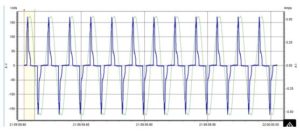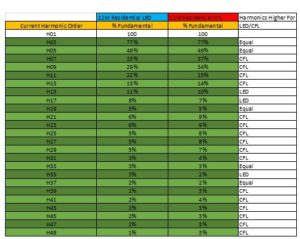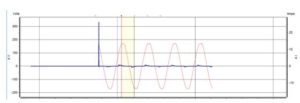CFL Lamp
Harmonics
CFL lights are non-linear devices in the sense that the current drawn from the supply does not follow the voltage. Current is drawn as short ‘bursts’ to charge the capacitor inside the CFL driver. In this aspect, the current waveforms will look very similar for CFL and LED lamps for non-power factor corrected lamps. Since the LED lamps have slightly more efficiency, we can expect to see lower peak currents compared to CFL lamps for similar wattage lamps. Voltage and current waveforms for a residential style 12W CFL lamp is shown below.

Voltage and Current Waveform for 12W CFL lamp.

As can be observed from the spectrum of the CFL current there are slightly higher high frequency harmonic components (25th, 27th etc). These could be attributed to the very sharp rising edges for the current waveform. A better driver front end design can lower the steep rise and hence lower the high frequency harmonic current.

Is this same as radiated interference?
Simple answer is is NO. The radiated interference to AM radios and other electronic device is different from the current harmonics measured at the lamp input side. The front end harmonic frequencies are of low frequency and cannot radiate from the lamps. Once the AC voltage is rectified in to DC, it is further switched at very high frequency (>10Khz). Some of these switching noise currents can radiate in to the immediate vicinity of the lamp and interfere with other electronic devices. AM radio are one of the most susceptible devices to these interferences and is usually an easy way to check the strength of the radiated fields. Just take and analog AM radio and hover over the lamp. Usually most lamps will create interference if the radio is very close. However the interference should quickly decay with distance if it is a nicely designed lamp complying with relevant EMI regulations.
CFL Lamp Switch ON Inrush Current
CFL lamps exhibit inrush current when initially switched ON. There will be an initial current surge, the magnitude of which will depend on the point of switching on the AC voltage waveform. The largest magnitude current results if the lamps is switched on the positive or negative peak of the AC voltage waveform.

Inrush current for 13W CFL lamp- 26.43A peak. Normal peak current draw is 0.532A
Observing the above waveform it is clear that switching ON and OFF the CFL lamp on a frequent basis cannot be good. Every time switch is closed, a high magnitude (relative to normal current) flows through the front end diode in to the capacitor. This will cause a temperature increase of the diode junction and if repeated frequently can damage the diode and hence the CFL driver.




